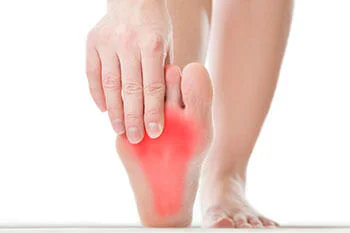Table of Contents
Anatomy
Causes
Capsulitis of the second toe is sometimes caused by trauma but is usually caused by abnormal foot architecture that alters mechanics over time. A bunion deformity, long second metatarsal bone, or a tight calf are some of the reasons why capsulitis at the base of the second toe can occur.
Symptoms
Usually early on there is pain in the ball of the foot with associated swelling. The condition is progressive as the plantar plate becomes stretched out and may tear, which is appropriately termed a “plantar plate tear.” The side-to-side support of the joint may also become compromised. The joint becomes unstable and the second toe begins to lift off the ground, which is a hallmark of the condition. In the later stages the toe begins to buckle and forms a stiff, contracted hammertoe. Finally, the digit may cross-over the big toe, also known as “Cross-over Toe deformity.”
Diagnosis
Nonsurgical Treatment
Capsulitis responds very well to conservative treatment in the early stages and these may include:
- Rest
- Ice
- Oral medications – Nonsteroidal anti-inflammatory drugs (NSAIDs), such as ibuprofen, can help relieve the pain and inflammation.
- Taping/splinting – Using tape or a small toe splint to pull the toe down puts slack in the plantar plate, which can heal once tension is removed.
- Stretching – Calf stretching can be particularly helpful in patients with tight calf muscles.
- Stiff soled shoes, especially those with a rocker bottom can be very helpful.
- Cross-over Toe deformity – these devices can be modified to take the pressure off the joint at the base of the second toe.
Surgical Treatment
In the advanced stages of this condition, surgery is often necessary. The combination of procedures differs on an individual basis and is tailored to address each area of pathology. For instance, surgery may involve repairing the plantar plate, as well as addressing the bunion deformity, tight calf muscle, long metatarsal, and/or hammer toe deformity if present. However, even when each of these deformities is corrected, the digit may drift back to cross over toe position especially in the advanced stages of this condition. The specialists at Integrative Foot and Ankle Centers of Washington have significant experience with this deformity and have published research as well as lectured on this topic.
What to Do Next?
If you or someone you know is experiencing pain or discomfort in your feet, seek out the help of a podiatrist for a proper diagnosis and treatment regime.
Contact us today to schedule an appointment.


